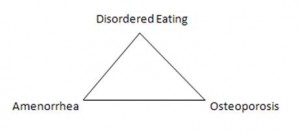
Understanding the Female Athlete Triad
Leave a CommentAs women’s involvement in athletic activity has increased dramatically in the last few decades, so has the incidence of female athlete triad. The incidence of female athlete triad is not well documented but studies have reported that anywhere from 15%-62% of female college athletes are affected. Female athlete triad is a syndrome comprised of disordered eating, amenorrhea, and osteoporosis or decreased bone mineral density. It can be present in athletes of any sport, but is most commonly seen in females participating in sports that emphasize leanness or low body weight such as gymnastics, figure skating, ballet, diving, swimming, and long distance running.
 Disordered Eating
Disordered Eating
Athletes with the triad often try to lose weight as a way to improve their performance in their sport. Disordered eating can range from unintentional consumption of too few calories to anorexia nervosa or bulimia nervosa, all of which result in low energy availability. Energy availability is the energy intake minus the energy expended. Energy comes from the consumption of food and is expended through bodily functions and daily activities, as well as exercise. Some athletes may believe that they are eating enough calories to support their activity, but this may not be the case. Low energy availability resulting from excessive exercise or dietary restrictions can result in the body not being able to carry out normal functions such as bone maintenance or a normal menstrual cycle.
Amenorrhea
Amenorrhea is defined as the cessation of a women’s menstrual cycle for more than three months. There are two types of amenorrhea. Primary amenorrhea is characterized by delayed menarche (onset of the first period). Secondary amenorrhea consists of a woman who has been having her period and then stops menstruating for 90 days. Amenorrhea occurs because the weight fluctuations from disordered eating or excessive exercise affect the output of hormones which stimulate the estrogen release from the ovaries. The menstrual cycle is disrupted because of the absence of estrogen.
Osteoporosis/ Low Bone Mineral Density
Immediate effects of female athlete triad on bone mineral density occur due to low estrogen levels. The deficiency in estrogen creates a high turnover state in the bone, which leads to low bone density and improper bone formation. As a result, bones are more brittle and therefore more susceptible to fracture. In addition, athletes who are restricting their diets may not be consuming enough calcium or vitamin D, which further contributes to the problem. The effect of this loss in bone mineral density at an early age can be detrimental to bone health throughout the lifetime as bone mass is now thought to peak between 18 and 25 years of age.
Signs and symptoms of the triad include disordered eating, excessive exercise in addition to training sessions, fatigue and decreased ability to concentrate, hair loss, cold hands and feet, dry skin, noticeable weight loss, increased healing time from injuries, increased incidence of fracture, and absence or irregularity of periods.
Treatment should be multidisciplinary and can include professionals including but not limited to physicians, dieticians, physical therapists, psychologists or psychiatrists, trainers, and coaches. Early intervention is important and decreases recovery time and long-term effects on health.
